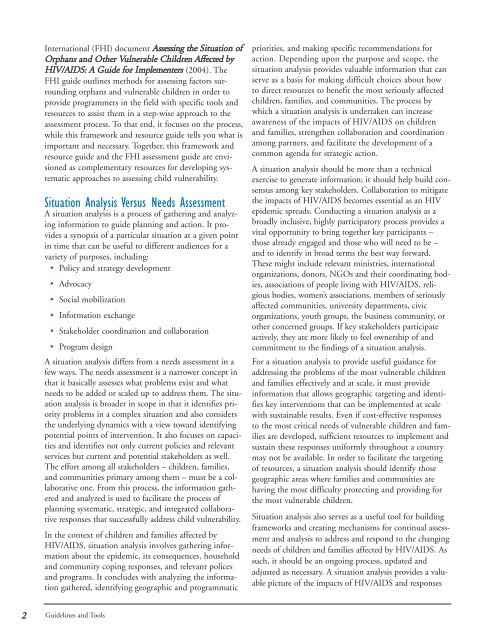Conducting a Participatory Situation Analysis of.pdf - Global HIV ...
Conducting a Participatory Situation Analysis of.pdf - Global HIV ...
Conducting a Participatory Situation Analysis of.pdf - Global HIV ...
Create successful ePaper yourself
Turn your PDF publications into a flip-book with our unique Google optimized e-Paper software.
International (FHI) document Assessing the <strong>Situation</strong> <strong>of</strong><br />
Orphans and Other Vulnerable Children Affected by<br />
<strong>HIV</strong>/AIDS: A Guide for Implementers (2004). The<br />
FHI guide outlines methods for assessing factors surrounding<br />
orphans and vulnerable children in order to<br />
provide programmers in the field with specific tools and<br />
resources to assist them in a step-wise approach to the<br />
assessment process. To that end, it focuses on the process,<br />
while this framework and resource guide tells you what is<br />
important and necessary. Together, this framework and<br />
resource guide and the FHI assessment guide are envisioned<br />
as complementary resources for developing systematic<br />
approaches to assessing child vulnerability.<br />
<strong>Situation</strong> <strong>Analysis</strong> Versus Needs Assessment<br />
A situation analysis is a process <strong>of</strong> gathering and analyzing<br />
information to guide planning and action. It provides<br />
a synopsis <strong>of</strong> a particular situation at a given point<br />
in time that can be useful to different audiences for a<br />
variety <strong>of</strong> purposes, including:<br />
• Policy and strategy development<br />
• Advocacy<br />
• Social mobilization<br />
• Information exchange<br />
• Stakeholder coordination and collaboration<br />
• Program design<br />
A situation analysis differs from a needs assessment in a<br />
few ways. The needs assessment is a narrower concept in<br />
that it basically assesses what problems exist and what<br />
needs to be added or scaled up to address them. The situation<br />
analysis is broader in scope in that it identifies priority<br />
problems in a complex situation and also considers<br />
the underlying dynamics with a view toward identifying<br />
potential points <strong>of</strong> intervention. It also focuses on capacities<br />
and identifies not only current policies and relevant<br />
services but current and potential stakeholders as well.<br />
The effort among all stakeholders – children, families,<br />
and communities primary among them – must be a collaborative<br />
one. From this process, the information gathered<br />
and analyzed is used to facilitate the process <strong>of</strong><br />
planning systematic, strategic, and integrated collaborative<br />
responses that successfully address child vulnerability.<br />
In the context <strong>of</strong> children and families affected by<br />
<strong>HIV</strong>/AIDS, situation analysis involves gathering information<br />
about the epidemic, its consequences, household<br />
and community coping responses, and relevant polices<br />
and programs. It concludes with analyzing the information<br />
gathered, identifying geographic and programmatic<br />
priorities, and making specific recommendations for<br />
action. Depending upon the purpose and scope, the<br />
situation analysis provides valuable information that can<br />
serve as a basis for making difficult choices about how<br />
to direct resources to benefit the most seriously affected<br />
children, families, and communities. The process by<br />
which a situation analysis is undertaken can increase<br />
awareness <strong>of</strong> the impacts <strong>of</strong> <strong>HIV</strong>/AIDS on children<br />
and families, strengthen collaboration and coordination<br />
among partners, and facilitate the development <strong>of</strong> a<br />
common agenda for strategic action.<br />
A situation analysis should be more than a technical<br />
exercise to generate information; it should help build consensus<br />
among key stakeholders. Collaboration to mitigate<br />
the impacts <strong>of</strong> <strong>HIV</strong>/AIDS becomes essential as an <strong>HIV</strong><br />
epidemic spreads. <strong>Conducting</strong> a situation analysis as a<br />
broadly inclusive, highly participatory process provides a<br />
vital opportunity to bring together key participants –<br />
those already engaged and those who will need to be –<br />
and to identify in broad terms the best way forward.<br />
These might include relevant ministries, international<br />
organizations, donors, NGOs and their coordinating bodies,<br />
associations <strong>of</strong> people living with <strong>HIV</strong>/AIDS, religious<br />
bodies, women’s associations, members <strong>of</strong> seriously<br />
affected communities, university departments, civic<br />
organizations, youth groups, the business community, or<br />
other concerned groups. If key stakeholders participate<br />
actively, they are more likely to feel ownership <strong>of</strong> and<br />
commitment to the findings <strong>of</strong> a situation analysis.<br />
For a situation analysis to provide useful guidance for<br />
addressing the problems <strong>of</strong> the most vulnerable children<br />
and families effectively and at scale, it must provide<br />
information that allows geographic targeting and identifies<br />
key interventions that can be implemented at scale<br />
with sustainable results. Even if cost-effective responses<br />
to the most critical needs <strong>of</strong> vulnerable children and families<br />
are developed, sufficient resources to implement and<br />
sustain these responses uniformly throughout a country<br />
may not be available. In order to facilitate the targeting<br />
<strong>of</strong> resources, a situation analysis should identify those<br />
geographic areas where families and communities are<br />
having the most difficulty protecting and providing for<br />
the most vulnerable children.<br />
<strong>Situation</strong> analysis also serves as a useful tool for building<br />
frameworks and creating mechanisms for continual assessment<br />
and analysis to address and respond to the changing<br />
needs <strong>of</strong> children and families affected by <strong>HIV</strong>/AIDS. As<br />
such, it should be an ongoing process, updated and<br />
adjusted as necessary. A situation analysis provides a valuable<br />
picture <strong>of</strong> the impacts <strong>of</strong> <strong>HIV</strong>/AIDS and responses<br />
2<br />
Guidelines and Tools















